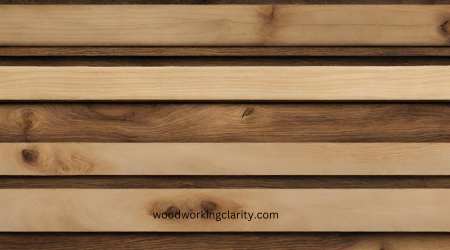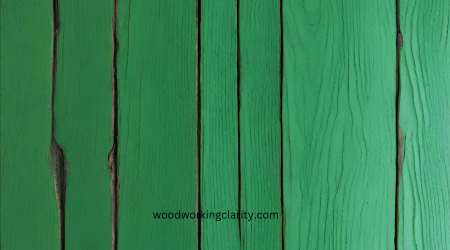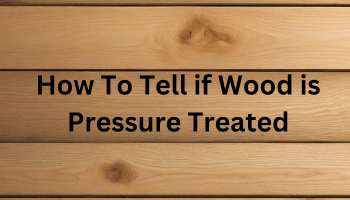You have your heart set on using pressure treated wood on your next project. But on the way to the hardware store, you’re still unsure how to tell if wood is pressure treated.
At first glance, all the wood looks the same. You, however, don’t have to worry. Here’s a simple guide to identifying pressure treated wood from non-pressure-treated wood.
How To Tell if Wood is Treated
To tell if the wood is treated, check tags, stamps, and markings of chemicals used. Smelling can also help you know if wood is treated. Treated lumber can smell oily, while untreated wood doesn’t. Treated wood also has a green or brown hue from the treatment process.
What Does Treated Wood Mean?

Treated wood refers to lumber that has undergone pressure treatment. In it, wood is placed in a pressure chamber full of liquid preservatives. High pressure is used so that the preservative will penetrate the lumber.
The most common preservative is alkaline copper quat or ACQ. This is because copper is poisonous to insects and fungi.
As a result, this lumber is less susceptible to insect and rot damage, water, and fire, but not to moisture, UV rays, and corrosion.
How do you Know if wood is Pressure Treated
All lumber may look the same, but you don’t need to be intimidated. Once you know the signs, you can identify pressure-treated wood.
Here’s a handy reference on how to tell the difference between treated and untreated wood.
1. Look for an End Tag
Look for a stamp telling you it’s pressure treated wood. The end tag should identify the preservative used, the rating, and the preservation company.
You’ll want to avoid using any wood that was treated with Chromated Copper Arsenate (CCA). This preservative includes a form of arsenic. This is why these have been prohibited for use in decks, playgrounds, and similar structures in an outdoor-residential setting since 2003.
2. Find the Stamp
It’s easy to find borate treated wood markings. A stamp that should tell you the type of wood and where you should use it.
For instance, If it says “FDN,” which stands for foundation, it’s one of the safest types of pressure-treated wood. Builders sometimes use these as the base underneath home flooring.
Borate treated lumber is equally safe. This is ideal for use inside the home as these are safe for people. These have the stamps Bor, Hi Bor, or Tim Bor.
This is ideal for use indoors, as it’s protected against termites. Outside not only can it rot, but it’s possible that its preservative wouldn’t get into the soil.
Avoid lumber stamped L P22. These have been treated with arsenic. Wood with an L P2 stamp, on the other hand, is less toxic but unsafe for home furniture.
3. Get a Fact Sheet
A fact sheet contains the list of chemicals used in wood pressure treatment. If these include Copper and Tebuconazole, it has undergone pressure treatment.
4. Check the Color
What does treated wood look like? In terms of look and color, pressure-treated wood can be green or brown in color. Some are tan or olive. The look might vary depending on the treatment procedure. This is because each preservative has a distinct hue.
5. Do the Smell Test
Pick up the chunk of wood and take a deep sniff, if in case you can’t spot a blue, brown, or green tint. Treated wood smells like oil or toxic chemicals, except for CCA treated, with no distinct smell.
6. Lumber Dimension
Most lumber for residential construction measures 8 (244 centimeters) to 16 ft. (488 cm).
Some 2×4 measurements and 2x6s sold as precut 92 5/8” long option what is a standard length of wall studs.
Wood injected with chemicals is usually a little bit wider and thicker than regular wood. This is because of the wood’s chemicals.
7. Use a Swipe Test Kit or Wood Testing Kit
Many commercial labs offer a swipe test kit that can identify treated wood.
8. Find the Retention Level
The retention level tells you how many preservatives were left after the pressure treatment. The higher the retention level, the more durable the wood.
Pressure treated Wood Color
As you already know, the color always matches with the chemicals used for wood pressure treatment.
Chromated Copper Arsenate – Green

Wood with a greenish color was infused with copper, chromium, and arsenic or CCA.
CCA was the most effective substance. It kills fungi, termites, and other pests. CCA wood, however, is poisonous to people and the soil.
Copper Azole (CA) – Brown
Wood with CA has little to no odor. It can be Type A with copper, boric acid, and tebuconazole, or Type B with more copper and tebuconazole but no boric acid.
CA can effectively protect pressure treated wood against mold, fungi, termites, and other insects.
ACQ – Tan or Olive
Alkaline copper quat or ACQ contains copper and a quaternary ammonium compound. ACQ protects against decay fungi and insects. It’s ideal for structural support such as fence posts- examples of hardwood are alder, balsa, and walnut.
Softwood lumber is naturally wetter since these have much more sap. The sap attracts fungus and other insects as these serve as their food. Softwood has natural pathways for the sap, which can also be used in treating wood. Examples of softwood trees are coniferous trees: yellow pine, white pine, spruce, and Douglas fir.
If you’re working with softwood and want to prevent sap from oozing out of the wood, we invite you to explore our comprehensive article on this topic.
How to Tell if Old Wood is Pressure Treated
Look for the greenish tint. Wood’s color changes after pressure treatment. It usually has a greenish tint unless the lumber has faded and turned to gray.
Contact the manufacturer or builder; as wood ages, its color fades and turns to gray.
Determine the age of the wood or project. If the deck is more than two years old, unless it’s made of cedar, more likely it has been infused with arsenic. You, however, have to take note that CCA has been banned for most residential use since 2003.
How to Tell if Plywood is Pressure Treated
Change in color. Treated plywood can have a green or brown color, a result of the treatment process.
Chemical or oily smell. Wood that has been treated has a chemical or oily smell as opposed to a pleasant natural smell of untreated wood.
It’s properly labeled. Here are the possible labels:
- UC1- meant for interior, dry purposes
- UC2- interior, can be damp
- UC3A- exterior, above ground, coated (rapid water runoff)
- UC3B- exterior, above ground, uncoated (poor water runoff)
- UC4A- ground contact, general use
- UC4B- ground contact, heavy-duty use
- UC4C- ground contact, ultra heavy-duty use
- UC5A- marine use, Northern waters
- UC5B- marine use, Central waters
- UC5C- marine use, Southern waters
- UCFA- interior, above ground, fire protection
- UCFB- exterior, above ground, fire protection
If you’re still in doubt, you can use a swipe test kit or wood testing kit.
Recommended read: Pressure treated wood vs marine plywood
How to Tell if Wood is Treated for Burning
Never burn pressure treated wood as this would release its chemicals. Plus, its ash is equally toxic. In short, there’s no pressure-treated wood that is meant for burning.
Read here to know exactly what to do if you accidentally burned pressure treated wood.
Advantages of Pressure Treated Wood Over Regular Lumber
- Moisture resistance: The treatment makes less permeable to moisture, thus less likely to develop fungi and mold.
- Fungal and insect resistance: Most pressure treated woods have copper-based compounds, such as ACQ and CA. Copper is poisonous to fungi and other microorganisms.
- Fire Resistance: Fire-retardant chemicals can be injected into the wood.
- Variety of Sizes: You can choose from the different sizes, according to your need.
- Durability: Treated wood last longer than untreated wood, despite exposure to the elements, moisture, and insects.
Safety Recommendations
- Wear Protective Gear– Use goggles, a dust mask, and gloves. Gather as much sawdust. Separately wash the clothes after working with treated wood.
- Wash Your Hands thoroughly with mild soap and water.
- Bleaching– Don’t use bleach, sodium hypochlorite, sodium hydroxide, sodium percarbonate, oxalic acid, and citric acid on wood infused with preservatives. These may cause the wood to release chemicals.
- Cut Wood in the outdoor areas– Wood preservatives are irritants to the nose, eyes, and skin. You’ll need space to avoid contact and inhaling the chemicals.
- Burning – Never burn treated wood as this may release the chemicals therein.
- Allow It to Dry– This prevents unwanted warping, cracks, splits, and gaps. When wood is wet, the moisture causes it to expand. But when it’s allowed to dry, it shrinks. This movement is what causes warping, which leads to splitting and cracks in the wood.
Dos and Don’ts Of Using Pressure Treated Wood Indoors
Provided you adhere to safety reminders, you can use pressure treated wood for indoor projects. Here are our tips:
- Check the type of lumber and the chemicals used. Lumber made to touch the ground contains the strongest chemicals, thus unsafe for indoor use.
- Identify borate treated lumber. Borate is safe to be used indoors. It protects wood from bugs, fungus, and other wood-decaying organisms.
- Use protective gear. Wear gloves, goggles, and a dust mask when handling treated wood.
- Don’t forget to clean up. Always gather sawdust to prevent unnecessary inhalation of chemicals in the wood.
- Never use pressure treated wood on surfaces that will have direct contact with food, animals, and people, the ground, and water contact. These include dining or picnic tables, chopping boards, and bed frames.
- Don’t recycle commercial wood materials. These include utility poles and railroad ties that have harsh chemicals.
- Stain exposed treated wood. This will create a protective barrier, especially against moisture.
See also: Can you put pressure treated wood directly on concrete?
Disposal: Follow Safety Recommendations
It would be best to dispose of old treated wood. Here are our tips on the proper disposal of pressure treated wood.
Careful Handling
If you can’t dispose of the lumber immediately, cut them into smaller pieces, then put them in specially marked bins.
Correct Disposal (video)
Check this YouTube video below for tips about removing pressure-treated wood safely.
If you have pressure treated wood that you want to dispose of, don’t burn it!
That is illegal in every state. Instead of burning, contact your local landfill and ask if they are approved to accept the treated wood, and they will let you know about approved disposal methods and regulations.
Why Does Pressure Treated Lumber Warp?
Treated wood warps because it hasn’t been dried after treatment. There’s no de-pressurized tank for this.
When the wood is wet, the moisture causes it to expand. But when it’s allowed to dry, it shrinks. This movement causes warping, which leads to splitting and cracks in the wood.
Is Arsenic in Pressure Treated Lumber?
Yes. There’s arsenic in some pressure treated wood. Up until 2003, the most common wood preservative was CCA. This contains arsenic. Plus, CCA leaches from wood to soil, putting plants, animals, and people in danger.
Given these, CCA treated wood was banned for residential use and can no longer be bought in hardware stores since 2003. But it’s still allowed for specific industrial purposes and commercial uses.
Does Treated Wood Corrode Aluminum?
Yes. Two wood preservatives Alkaline Copper Quaternary (ACQ) and Copper Azole (CA), contain copper that discolors and causes corrosion when in direct contact with aluminum.
Pressure treated wood drying time
Pressure-treated wood requires approximately 6 to 12 months to dry before applying finishes or using in projects. Drying time depends on treatment, climate, and wood size. Humid areas might necessitate longer drying. Consider local conditions for best results in outdoor construction and preservation.
How do you tell if pressure treated wood is dry?
Do the water test. Sprinkle water on the wood. If the wood absorbs the water, it’s dry enough. Otherwise, water beads will form on the surface.
Who Makes the Treated Lumber Rules?
The American Wood Protection Association (AWPA) is responsible for spreading voluntary wood preservation standards. AWPA standards are the only ones referenced in both the International Residential Code (IRC) and the International Building Code (IBC).
You can find “AWPA,” and the applicable standard, usually “U1” on the lumber’s end tag. Thus, by looking at the tag, you don’t have to wonder how to tell if that 2×4 is treated.
FAQs
Should I use treated or untreated wood for a deck?
It’s better to use treated wood for a deck since it’s more resistant to decay and insects. Untreated wood used outside won’t last as long, especially if you get a lot of rain in your area. But before you start assembling your deck or any other project, make sure your wood is dry.
What is salt treated lumber?
Salt treated lumber is another term for pressure treated wood, preserved with sodium borate, copper naphthenate, and other salts. These salts are forced into the wood when it’s placed in a pressure chamber. To make sure the preservative penetrates the wood fibers, tiny holes that look like marks are strategically placed. This is the answer in case you’re wondering “why does pressure treated wood have marks?”
What is pressure treated wood treated with now?
Newer wood preservatives include ACQ, borates, CA, copper- HDO, and polymeric betaine. These chemicals are considered to be safer than chromated arsenicals (including Chromated Copper Arsenic) used before the year 2003. In case you’re wondering, “how do I know if my wood was treated with CCA?” You can usually recognize CCA pressure treated wood by its greenish tint, especially on the cut end, and staple-size slits that line the wood.
What color is pressure-treated wood?
The color of the treated wood varies from light brown to a faint olive green hue to dark green, depending on the type of oil and treating process. The oil’s odor may be noticeable near the treated wood. The lumber is difficult to paint or stain unless pressure treated using a light oil.
What is the difference between pressure treated and untreated lumber?
Pressure treated wood is no stronger than untreated wood. The difference between the two is, wood that has been treated will resist the elements better than untreated due to chemical preservatives added, and so will maintain its integrity in conditions that would cause normal wood to rot.
And to the question, is new pressure treated wood safe? It’s safe with proper handling and use, and disposal. It is best to use it in projects without direct contact with people, animals, plants, and soil.
Does sealing cut pressure treated wood prevent root?
Sealing cut pressure-treated wood helps prevent rot, decay, and structural damage caused by moisture, but it may not completely prevent rot caused by exposure to soil and roots. Proper installation and use of a suitable barrier, such as a plastic or rubber membrane, is recommended for wood in contact with soil
Related: What Does Teak Wood Look Like?
Final Thoughts on How to Identify Pressure-treated Wood
Remember to check the tags and stamp markings of chemicals used. The green or brown color will also help identify treated wood. And even the odor of the lumber. If still in doubt, ask your favorite hardware store staff member.
Best to be sure so that you’ll know which one to purchase and get to enjoy the benefits of using pressure-treated wood.
But then again, by following our tips, you’ll be an expert on how to tell if wood is pressure treated or not.


Everything but what I wanted to know…what type of pt can contact the ground…can you put pt 6×6 right in the ground?
Treated wood for ground contact is labeled as ground contact wood. Look for tags that say uc4a or uc4b.